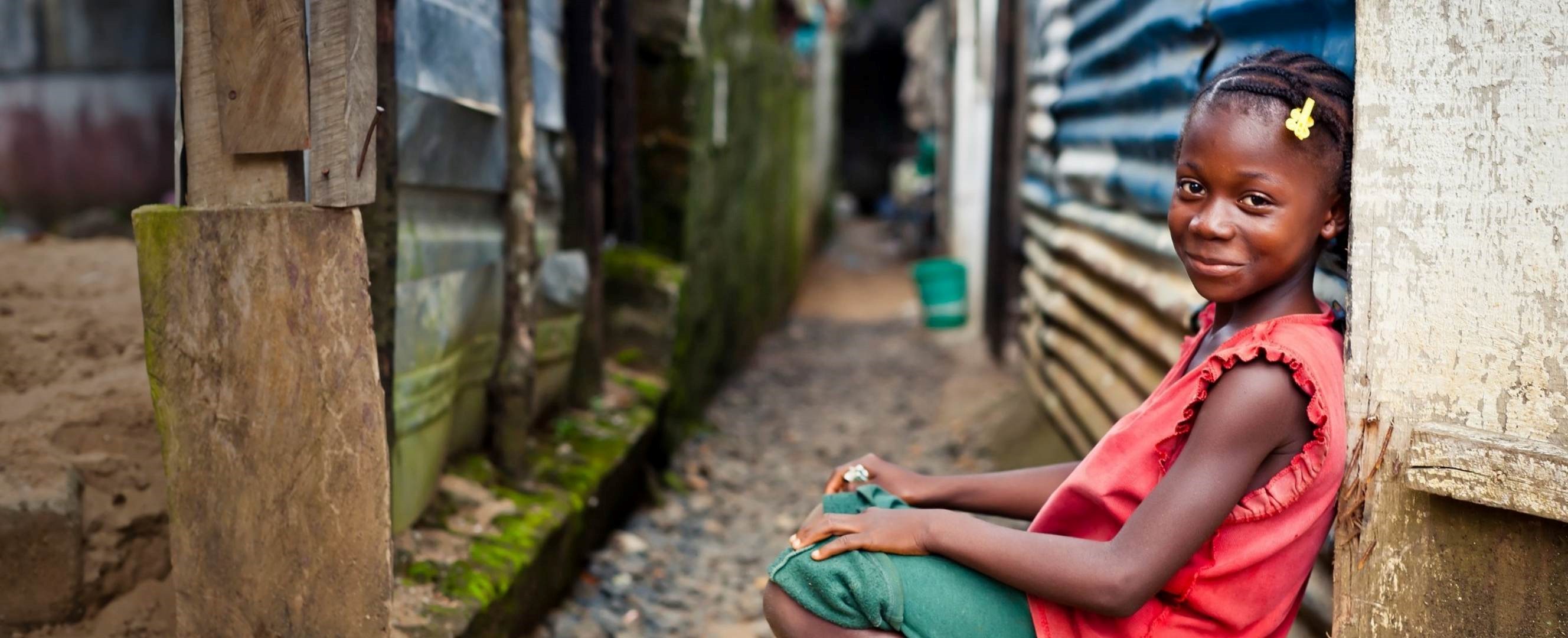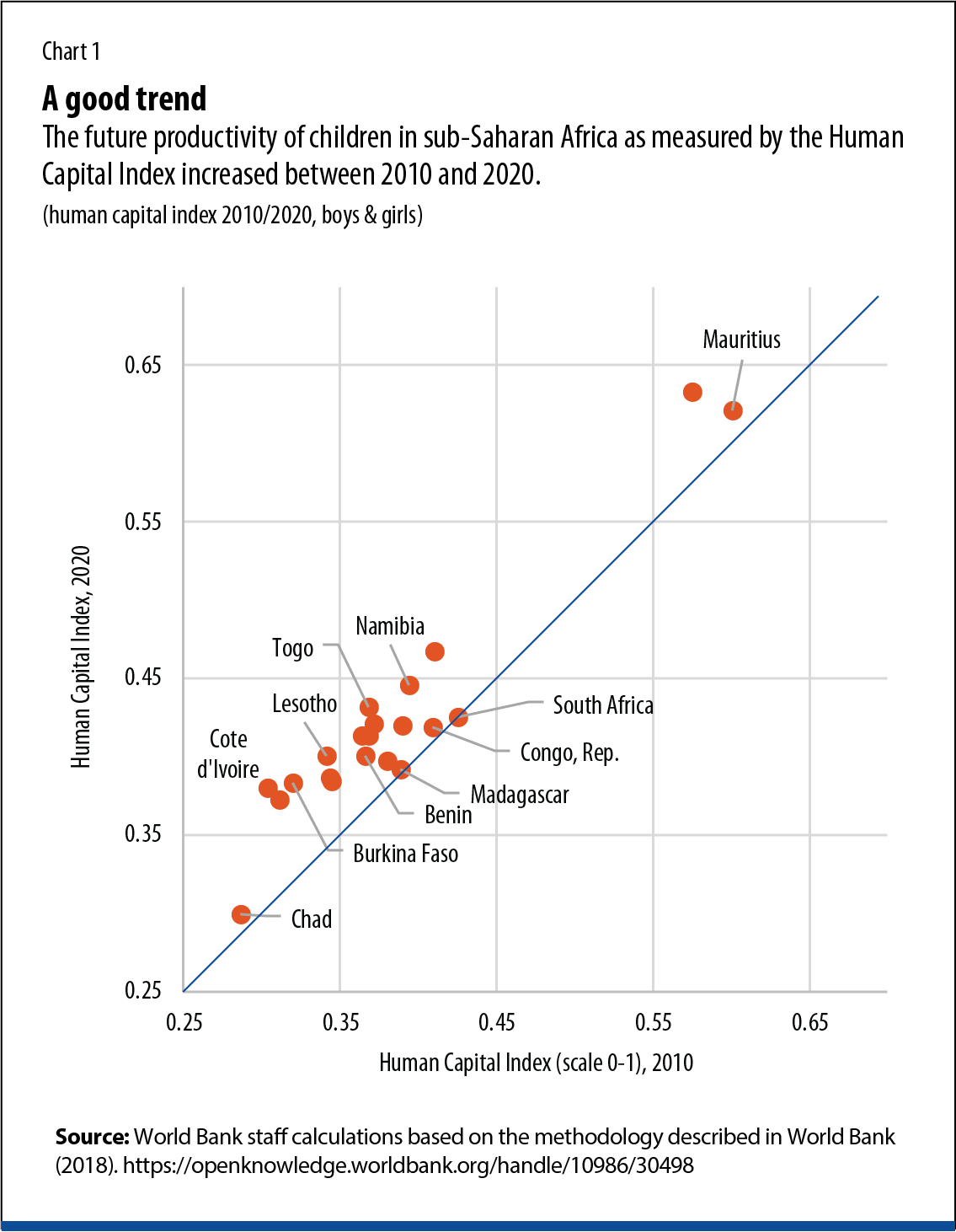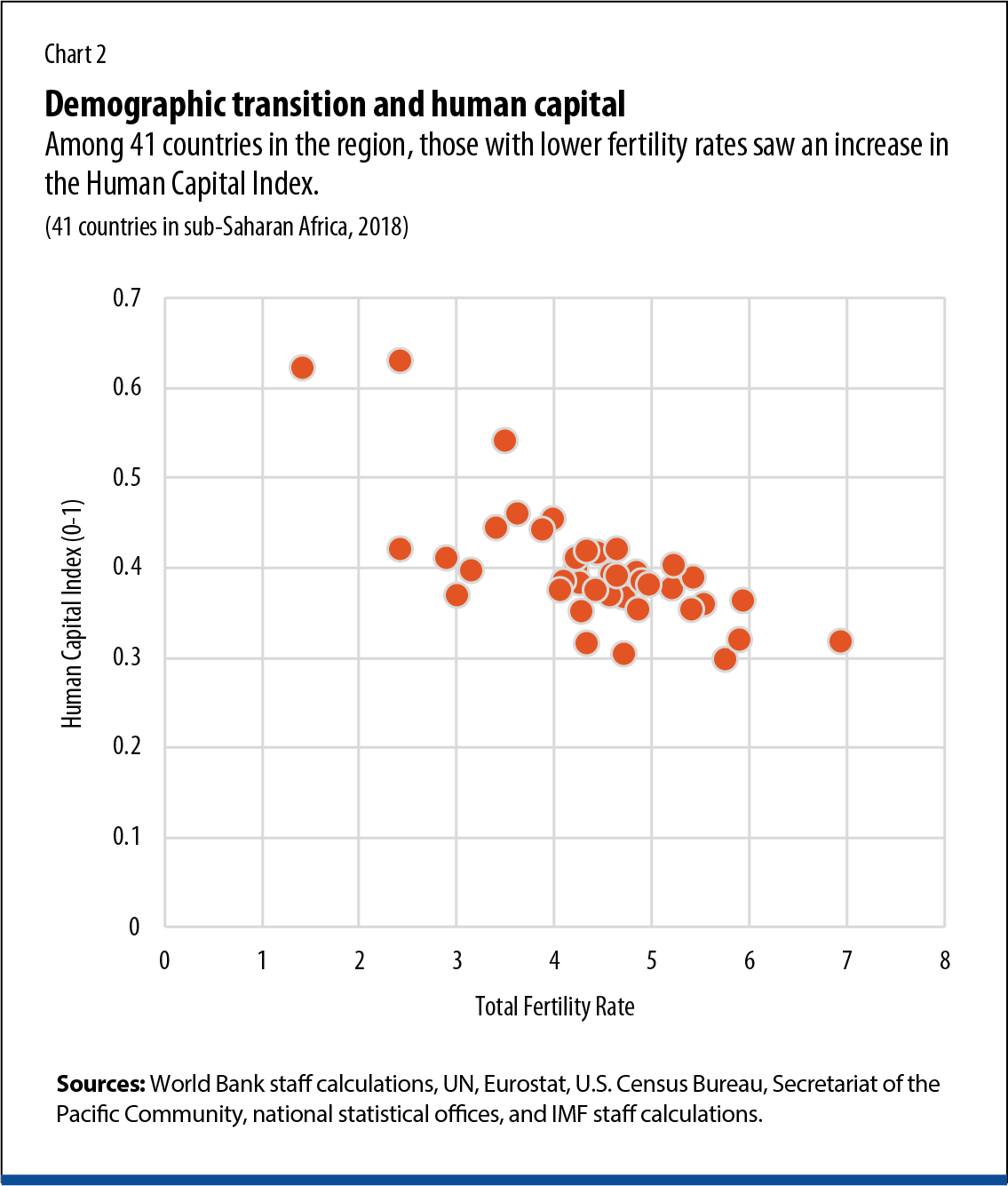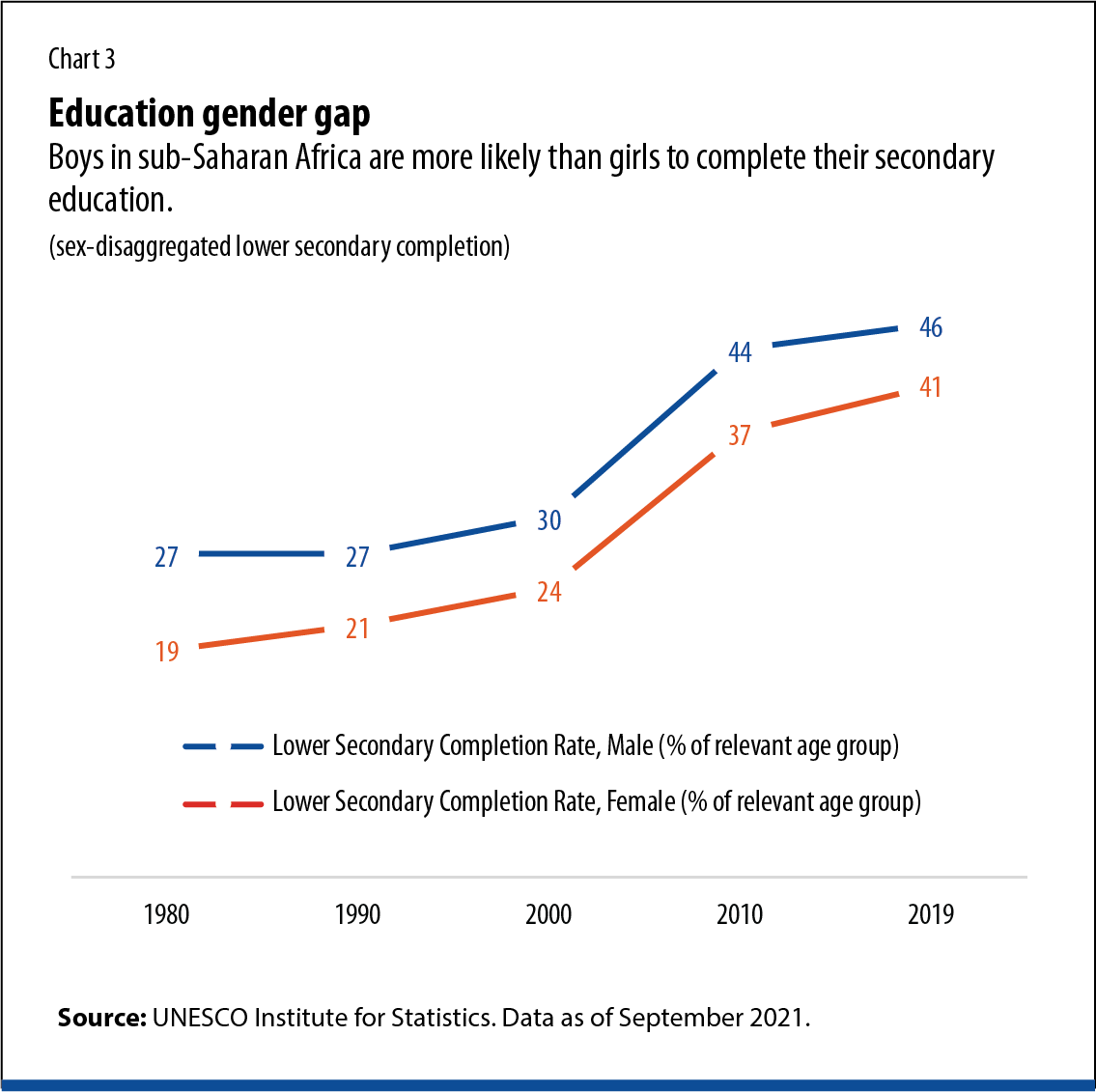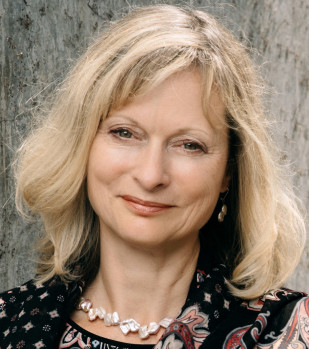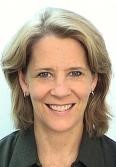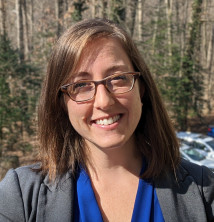F&D Special Feature: Africa at a Crossroads: Learning from the Past and Looking to the Future
A comprehensive effort could unlock the region’s potential and spur recovery
Since decolonization, Sub-Saharan Africa has made great progress on human capital–the knowledge, skills, and health that people accumulate throughout their lives, enabling them to realize their productive potential. The region’s progress is, in large part, a result of improved access to services and narrowing gender gaps in education, health, nutrition, and social protection.
Sub-Saharan Africa’s progress is measurable. The Human Capital Index, which measures children’s future productivity relative to a benchmark of full health and complete education, increased in nearly all sub-Saharan countries from 2010 to 2020 (Chart 1). Since 1990, the under-five mortality rate has plummeted and life expectancy at birth increased from forty years in 1960 to sixty-two years in 2019. Primary and secondary school enrollment has doubled since 1970, partially offset by low learning outcomes (UNESCO, 2021).
Across the region, higher HCI has coincided with lower fertility (Chart 2) (UNFPA, 2020; World Bank, 2018). Notably, Kenya’s contraceptive prevalence rate rose from 4 percent in 1978 to 56 percent in 2019. In Ethiopia, the fertility rate for adolescent girls fell from 116 births per 1,000 in 1960 to sixty-three in 2019 (UNFPA, 2020).
Prior to the COVID-19 pandemic, Africa was on the cusp of demographic transition, driven by falling birthrates and rising overall life expectancy. Securing this transition and investing to harness the benefits is essential to Africa’s future.
Today’s challenges
Despite encouraging progress, sub-Saharan Africa still has some distance to go. The region
has attained only 40 percent of its productive potential as measured by the HCI. The number of children who die before age five remains high, at close to three million every year. Most deaths are from avoidable causes, such as complications from respiratory infections, diarrhea, or malaria. Childhood stunting, an indicator of undernutrition, affects one in three children in Sub-Saharan Africa (Baye, Laillou and Chitweke, 2020).
A combined measure of schooling quantity and quality—the learning-adjusted years of schooling – shows many Sub-Saharan African countries performing below what their income level would predict. (Filmer et al., 2018). Furthermore, sub-Saharan Africa is the only region of the world where the percentage of out-of-school adolescents rose recently, from 35.9 percent in 2018 to 36.6 percent in 2020 (UNESCO, 2021).
Across most of sub-Saharan Africa, females fall behind males in human capital and related measures. Girls are less likely than boys to complete secondary education (Chart 3), often due to child marriage, adolescent pregnancy, and domestic work. Actual fertility remains above desired fertility as adolescent girls and women lack fully realized reproductive rights and access to quality, affordable reproductive health care. In the labor force, women’s productivity lags due to constraints on ownership rights and access to markets, financing, and productive inputs.
COVID-19 setbacks
The COVID-19 pandemic has undercut human capital accumulation and gender equity. In low- and moderate income countries, estimates point to an increase of up to a 45 percent in deaths under age five and a 39 percent increase in monthly maternal mortality (Roberton, et al., 2020). Extreme poverty in Sub-Saharan Africa could lead to another ten million children under age five suffering from acute malnutrition and a 30 percent increase of undernourished households. Gender-based violence and child marriage has increased from already high levels in many sub-Saharan African countries.
Education has been hit hard by the pandemic. In low- and middle-income countries, learning poverty (the percentage of ten-year-olds who can read and understand a simple text) is at 53 percent. COVID-9 is likely to severely limit progress on reducing learning poverty in these countries. Dropout rates are expected to increase, especially for adolescent girls at an elevated risk of child marriage, adolescent pregnancy, and domestic work (Azevedo, et al., 2021).
COVID-19’s devastating impacts on jobs and livelihoods has been especially harmful to those working in informal sectors, chiefly women. We also know that women are more likely to reduce work hours or drop out of the labor force during crises. Before the pandemic, women dedicated on average 3.2 more time than men to unpaid care work (ILO, 2018). Increased childcare responsibilities due to the pandemic pose challenges for the continent’s women and girls. A June 2020 survey by the World Bank, Facebook, and the OECD found a large gender gap in pandemic-related business closures in Nigeria, with 44 percent of female-owned businesses surveyed closing, compared to 33 percent of male-owned businesses.
Pandemic aside, sub-Saharan Africa faces challenges from climate change, forced migration, slowing investment growth, and rising poverty and inequality. Women and girls are more likely to be affected by these challenges due to discrimination and gender and social norms. For example, reduced access to water resulting from climate change may shorten the time that girls can spend on schooling, as it is their responsibility to collect water. Emerging evidence suggests women are more likely than men to suffer from climate-related food insecurity and to experience mental illness or partner violence following extreme weather events.
Unleashing the human capital of women and girls would help sub-Saharan Africa to recover from the COVID-19 pandemic and strengthen its social and economic prospects. The links between girls’ education and economic gains are well established. In Africa, each additional year of schooling raises a man’s earnings by 11 percent and a woman’s earnings by 14 percent. Furthermore, given the dynamic and cumulative process of capital formation, investments that benefit women today also benefit future generations.
Moving Forward
The Africa Human Capital Plan presents a “4 E” framework to guide investments in women and girls’ human capital:
Education and Skills for Future Jobs: Affordable, quality schools, and skills to prepare for the global labor market. Investing in teachers and creating safe schools is essential to childhood education. Cash transfers can help more students attend and stay in school. Mentoring can encourage girls to pursue STEM education and trade specialization, including in the digital and green economy. Life and soft skills training can help young women develop self-confidence and expand their career aspirations.
Enhanced Sexual and Reproductive Health Rights: Utilization of quality, affordable sexual and reproductive, adolescent, and maternal health services. Experience shows that community outreach and communication campaigns that engage traditional leaders and influencers to change mindsets and behaviors is as important as service delivery.
Economic Inclusion and Jobs: Finance, technical assistance, productive jobs, and income support. Access to capital, support for entrepreneurship, and enhanced childcare can boost women’s earnings and economic growth overall. Tackling barriers to property rights and formal-sector employment can reduce women’s concentration in poorly paid informal-sector jobs. Mentors and role models can encourage a move to higher paying, traditionally male occupations. Digital cash transfers provide an opportunity to strengthen inclusion and access to financial services.
Empowerment and Voice: Changing social and gender norms. Freeing women and girls from the scourge of child marriage, undesired pregnancies, and gender-based violence requires a shift in social roles and norms, as well as more inclusive policies and legislative reforms.
Adopting this four-part framework can be a game changer for sub-Saharan Africa, resulting in development that is sustainable, resilient, and inclusive.
Opinions expressed in articles and other materials are those of the authors; they do not necessarily reflect IMF policy.
References:
Azevedo, João Pedro, Amer Hasan, Diana Goldemberg, Koen Geven, Syedah Aroob Iqbal. 2021. “Simulating the Potential Impacts of COVID-19 School Closures on Schooling and Learning Outcomes: A Set of Global Estimates.” The World Bank Research Observer, Volume 36, Issue 1, February 2021, Pages 1–40, Supplementary Online Appendix.
Filmer, Deon; Rogers, Halsey; Angrist, Noam; Sabarwal, Shwetlena. 2018. Learning-Adjusted Years of Schooling: Defining A New Macro Measure of Education. Policy Research Working Paper; No. 8591. World Bank, Washington, DC. https://openknowledge.worldbank.org/handle/10986/30464
Hillis, Susan D., H. Juliette T. Unwin, Yu Chen, Lucie Cluver, Lorraine Sherr, Philip S. Goldman, Oliver Ratmann, Christl A Donnelly, Samir Bhatt, Andrés Villaveces, Alexander Butchart, Gretchen Bachman, Laura Rawlings, Phil Green, Charles A Nelson 3rd, Seth Flaxman. 2021. Global minimum estimates of children affected by COVID-19-associated orphanhood and deaths of caregivers: a modelling study. The Lancet, 398(10298), 391-402.
ILO. 2018. “Care work and care jobs for the future of decent work.” International Labour Organization, Geneva.
IMF. 2015. “Regional Economic Outlook for Sub-Saharan Africa.”
Roberton, Timothy. Emily D Carter, Victoria B Chou, Angela R Stegmuller, Bianca D Jackson, Yvonne Tam, Talata Sawadogo-Lewis, Neff Walker. 2020. “Early estimates of the indirect effects of the COVID-19 pandemic on maternal and child mortality in low-income and middle-income countries: a modelling study.” Lancet Global Health 2020; 8: e901–08 https://0-doi-org.library.svsu.edu/10.1016/ S2214-109X (20)30229-1
UNESCO. 2021. “Lower Secondary Completion Rate, Sub-Saharan Africa.” UNESCO Institute for Statistics. Data as of September 2021.
United Nations Population Division. 2020. World Population Prospects.
WHO, UNICEF, UNFPA, World Bank Group, and the United Nations Population Division. 2019. “Trends in Maternal Mortality: 2000 to 2017.” Geneva, World Health Organization. World Bank, 2018. “Human Capital Index (HCI) (scale 0-1)- Sub-Saharan Africa.” World Bank staff calculations based on the methodology described in World Bank (2018).
World Bank Africa Human Capital Plan
World Bank Group. 2019. Profiting from Parity: Unlocking the Potential of Women's Business in Africa. World Bank, Washington, DC. https://openknowledge.worldbank.org/handle/10986/31421
World Bank, Facebook, and OECD. 2020. “Future of Business Surveys.”




